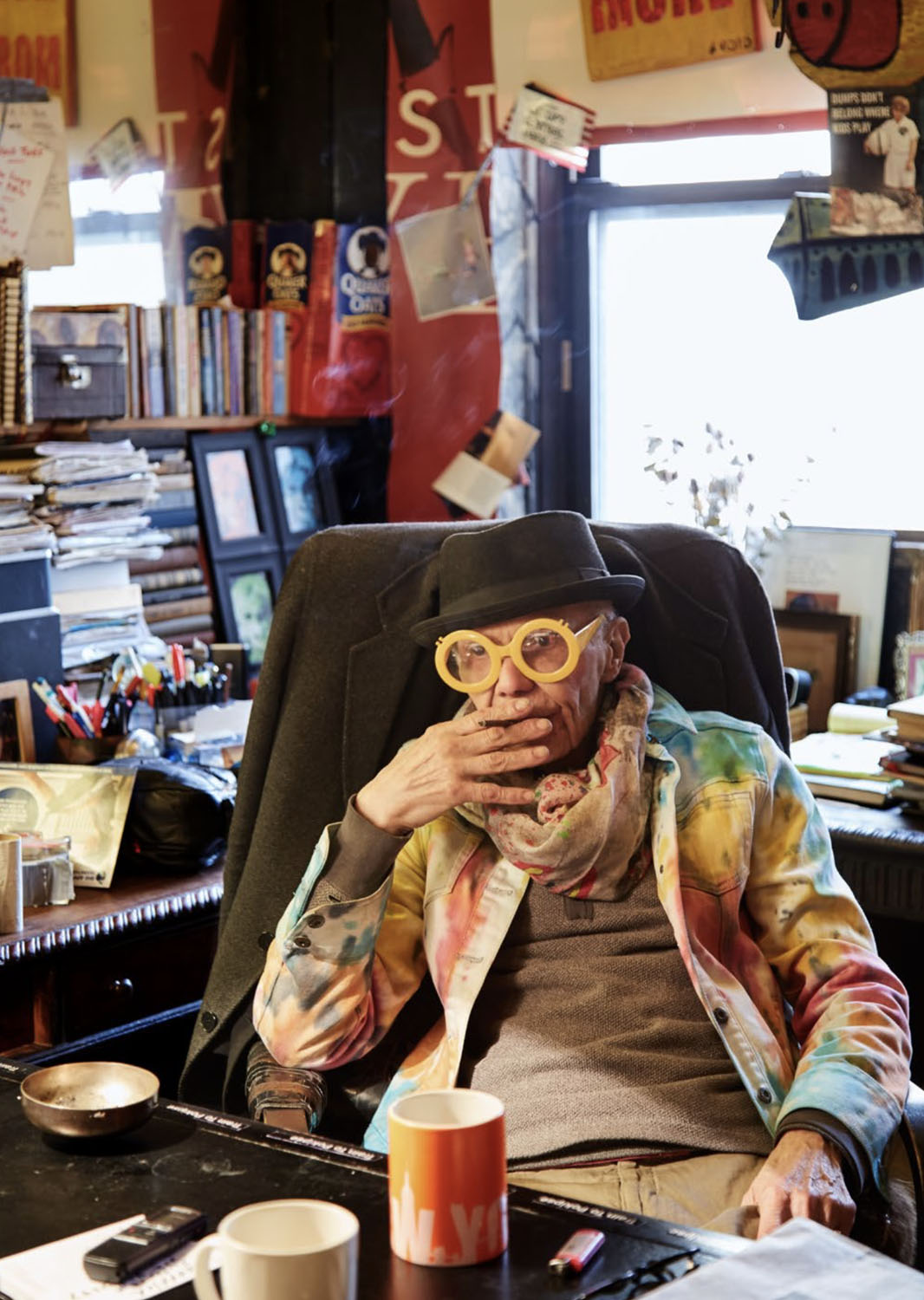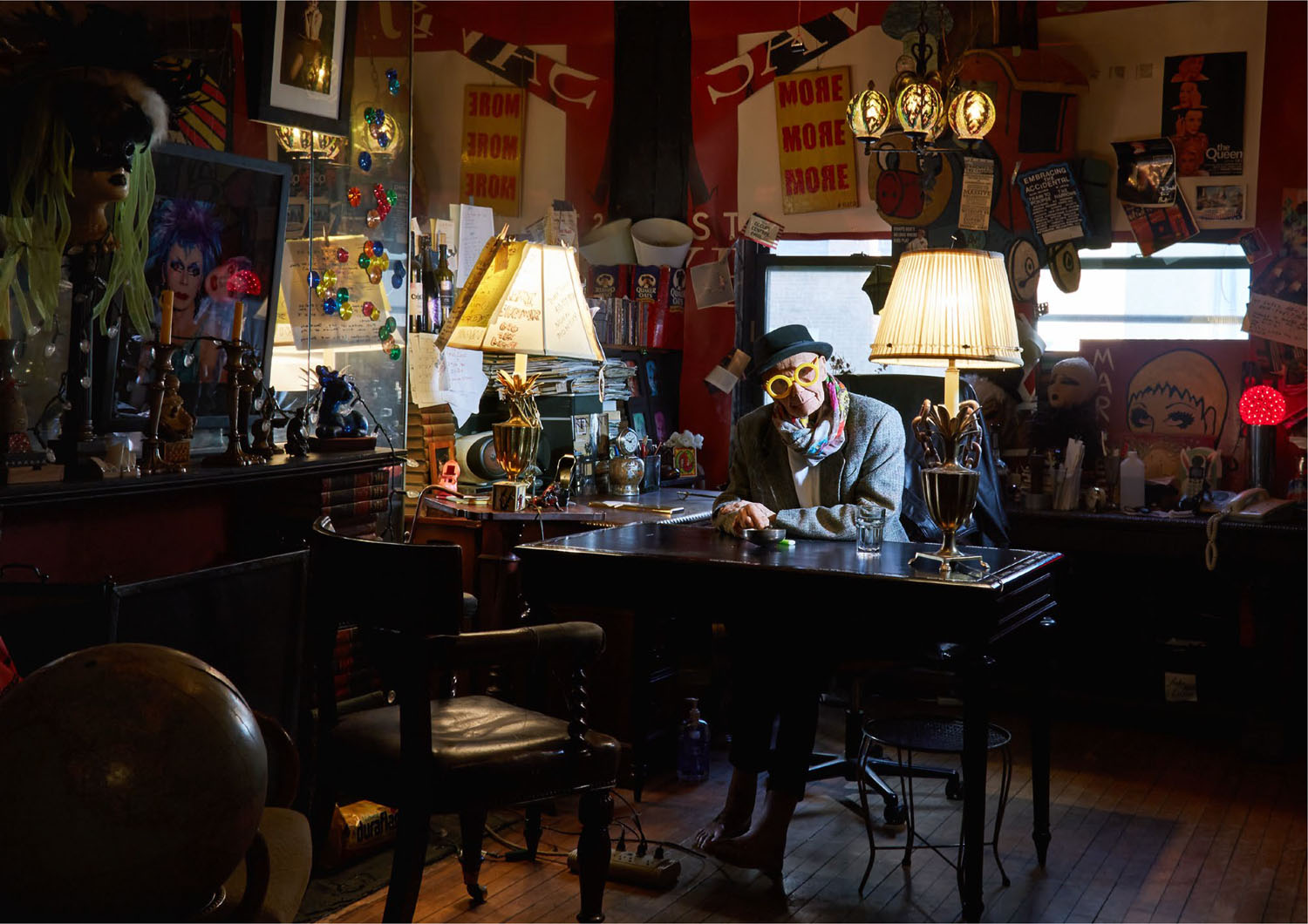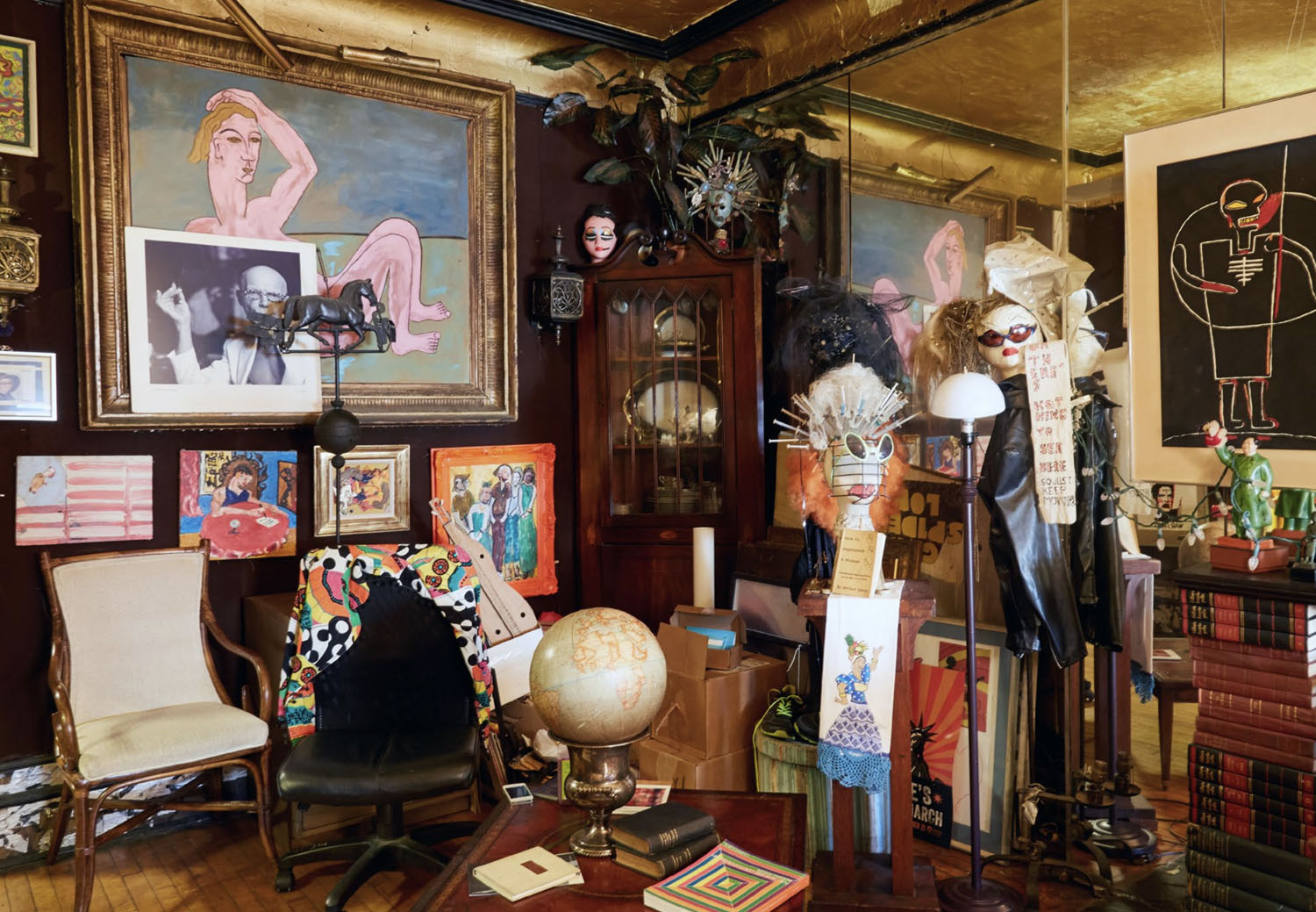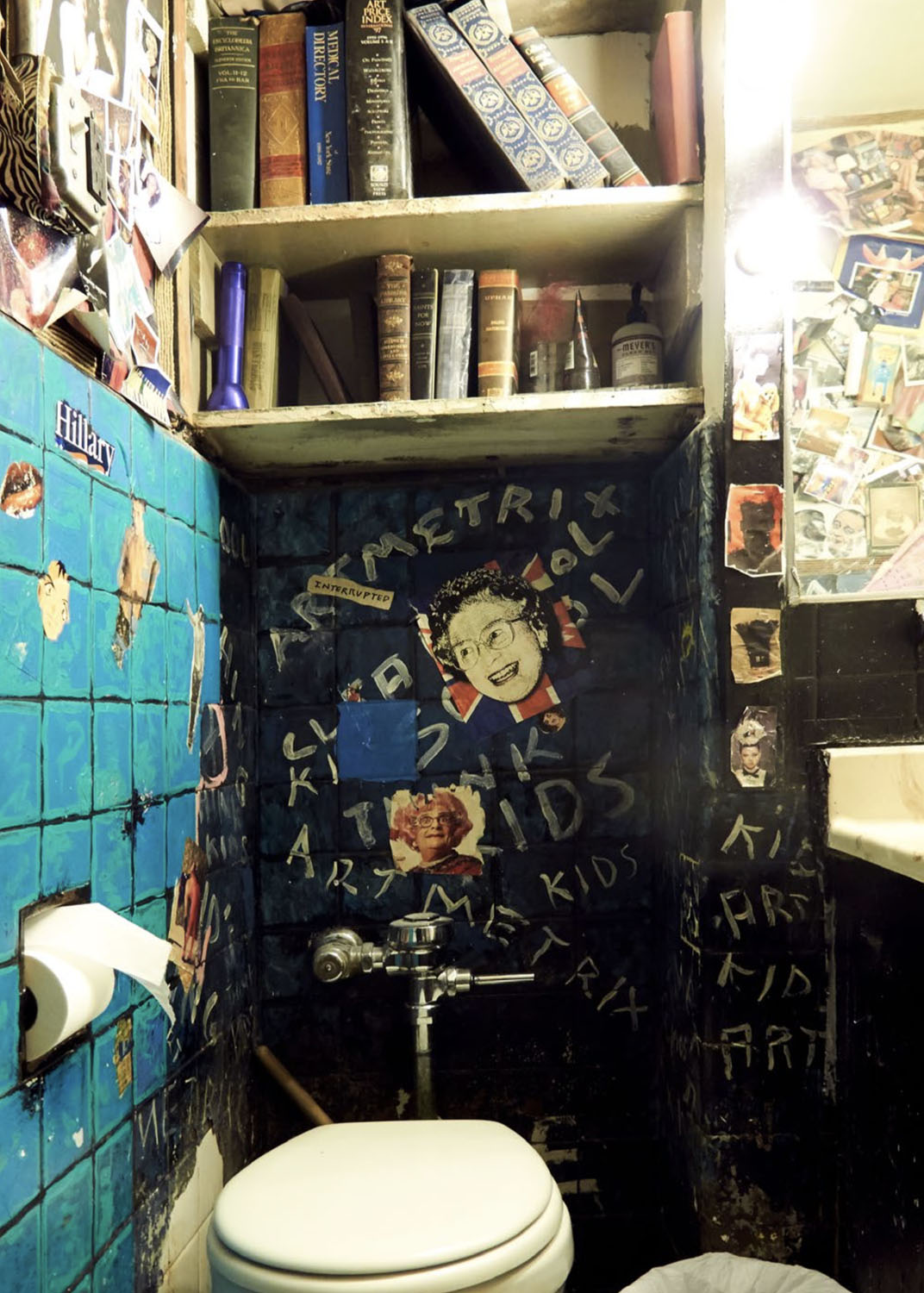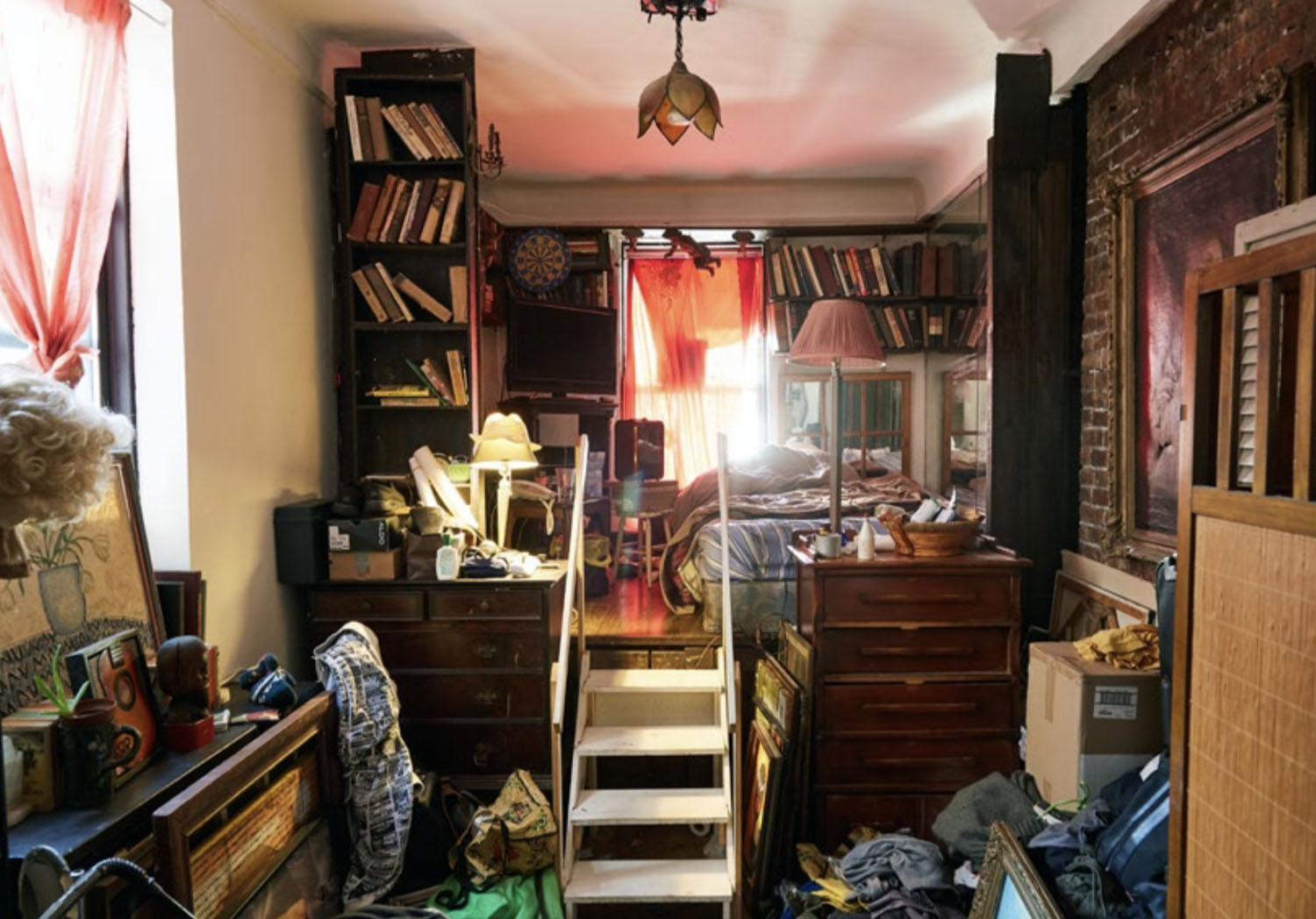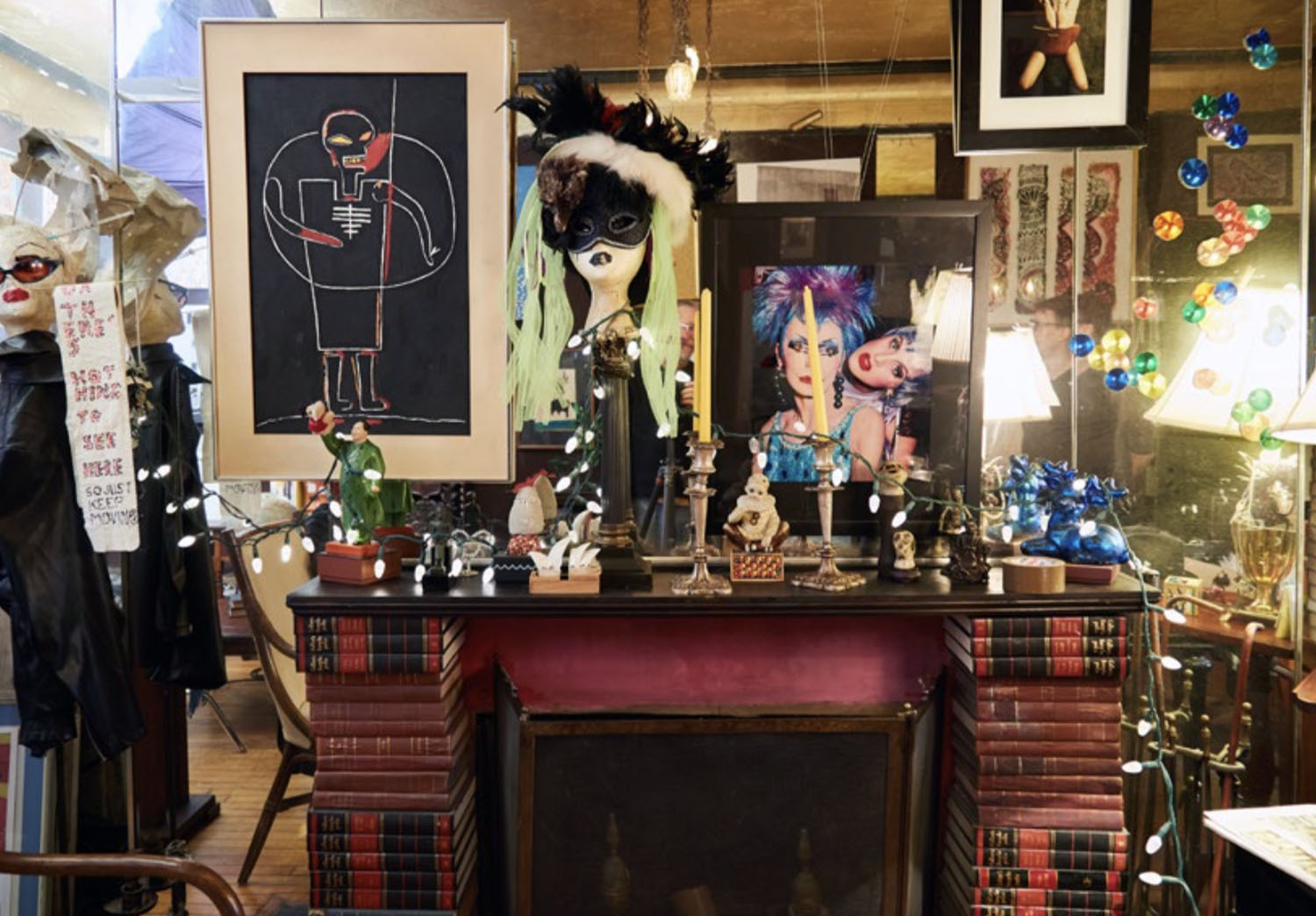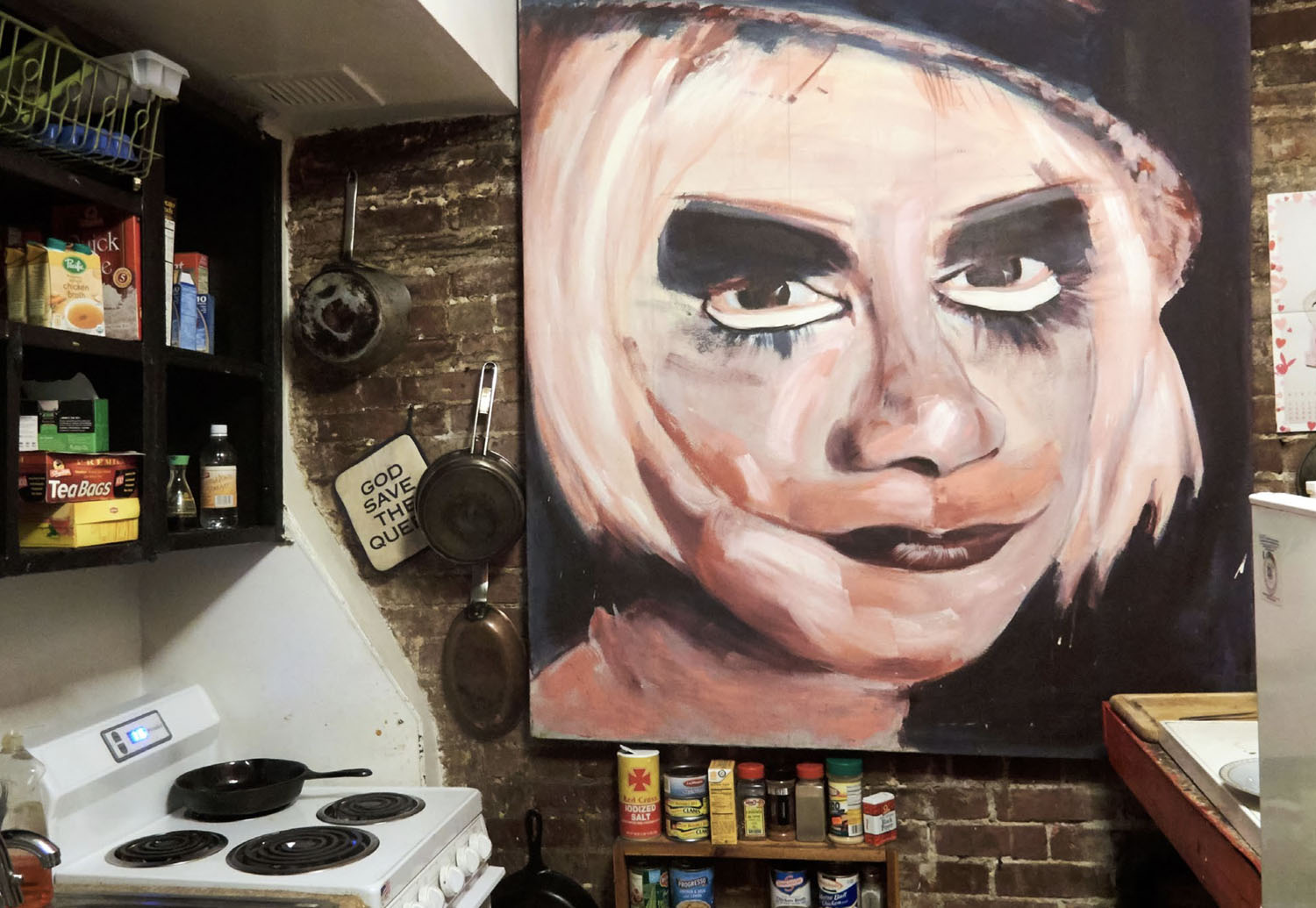FLAWLESS SABRINA
Interview by Michael Bullock
Photography by Vincent Dilio
Apartamento 19, 2017
On the Upper East Side of Manhattan, through a posh façade and up five flights of stairs, artist Curtis Carman, the charismatic life partner of Flawless Sabrina, greets me and ushers me through a jam packed room that has elements of both a nightclub and a study. He delivers me to sit with Flawless at her desk. The experience feels like a queer version of The Godfather, with Flawless as Don Corleone. When you experience the famous optimism of Flawless Sabrina in person, it’s clear how she became an icon. At 77 she has the energy and enthusiasm of a motivational speaker. She doesn’t give me a second to feel bad about the current political situation and instead relentlessly encourages empowerment over despair. ‘You’re the boss, applesauce’, she tells me. And coming from the matriarch of gay culture, I believe it. In 1958, against all odds, Jack Doroshow founded America’s first national drag beauty pageant. This radical endeavor gave birth to Flawless Sabrina: a pushy, charismatic ‘bar mitzvah mother’. She was designed to host the pageant without competing with the contestants. It spread like wild fire. She ran 46 pageants a year for a decade, culminating in the legendary 1968 documentary The Queen, a cornerstone of queer culture whose lasting influence can be seen today in both ballroom culture, and in the mainstream mega hit RuPaul’s Drag Race. And while The Queen is an enormous chapter in gay history, it’s just one of the many chapters in Flawless’ fabulously storied life. A life which has taken her everywhere, from Hollywood (working as a consultant to film’s such as Midnight Cowboy and Myra Breckinridge) to Washington (where she collaborated with Hillary Clinton to pass transgender rights legislation) and to the art world (where she’s recently been collaborating with mentee, artist, and producer of the TV series Transparent, Zackery Drucker).
You moved to New York in 1967?
I moved here to film The Queen. Up until that point I had run the pageant out of Philadelphia. I was 19 when I started it.
It’s incredible in The Queen to see a full orchestra backing up your contestants as they sing. I’m curious about the scale and economics of your pageant.
What a smart boy you are to realise those things! Yes, it wasn’t cheap, especially housing all those girls. But there was no other forum like it; we needed it to exist. For about a decade I ran 46 regional pageants a year and created over a hundred jobs for gay kids, let alone all the drag queens I employed.
What were they all doing?
Working the phone network, making calls, like, ‘Show tomorrow night!’ You had to gather numbers and have phone lists. Drag was illegal, so you couldn’t promote with fliers. You’d find the loudest, most energetic queens in each city. They didn’t use the term ‘community’ back then. It wasn’t until well after the Stonewall riots that people thought, ‘Oh, we are a community, we can talk to each other and know each other’.
Is it true that Bobby Kennedy once helped you book a venue for the pageant?
Bobby Kennedy was what you’d call a tranny-chaser. He helped me book but the The Ritz Carlton in Boston but it was a disaster. The first two rows were all these fancy rich kids that came to see these ‘monkeys dressed in dresses’. I knew the bloom was off the rose. That’s when I decided it needed to be documented before it was to late.
What was Andy Warhol’s role in making The Queen?
Andy Warhol came to my first contest in Pittsburgh around 1961. I didn’t know who he was then, but years later when I wanted to make the film, Andy was the first person I went to. He was very helpful. He agreed to be one of the judges and connected me with some financiers who put up $10,000 in seed money. One of the things that he made clear from the beginning was that it had to be a documentary that involved the film establishment so it would be taken seriously. And he was absolutely right, that’s how we ended up at the Cannes Film Festival. He brought in Lewis M Allen, who was famous for Fahrenheit 451 and Lord of the Flies, and Si Litvinoff, who made A Clockwork Orange and The Man Who Fell to Earth.
How was The Queen received?
Renata Adler described it as ‘extraordinary’ in her New York Times review. She said my girls were ‘not female imitations at all, but parodies’ and ‘very witty, detailed parodies at that’. She said, ‘They may be absolutely miserable in their private lives ... but in their costumed appearances they enrich the landscape enormously’. There was no sex in The Queen, but when it came out it was given an XXX rating. That made distribution incredibly difficult. For many decades the New York Public Library wouldn’t include it in its collection because of its rating.
Well, it’s a much bigger transgression than sex; your film attempted to erode the patriarchy! Could you ever imagine that your pageants would pave the way for drag to be not just accepted but actually celebrated by a mainstream audience?
I had no way of knowing that RuPaul was going to come along and do something so marvellous and put the whole phenomenon in everyone’s living room. When I was running the pageants what we were doing was considered mental illness. I had over 100 arrests. I always thought it was hilarious that a man in a black dress found me guilty of a felony for being a man in a dress. The whole binary thing is so stupid. It’s actually not that old; the lines used to be much more blurry. Defining yourself in these absolutes really only started with all this computer stuff. These black and white distinctions, up or down, fat or thin, old or young. Life isn’t like that. There are nuances, and those nuances are what make us individuals. If you’re an individual, you set yourself apart from the wrath of these moronic absolutes.
For me the problem in binary gender stereotyping is there are only a few people that exist naturally on the poles of extreme masculinity or extreme femininity the football captain or the head cheerleader. And yet society holds those archetypes up as the gold standard that everyone is judged by. When you’re growing up that makes you feel inadequate. For most people hyper-masculinity and hyper-femininity are both a form of drag.
Culture is not conducive to being comfortable in your own skin. But you have a responsibility for your own identity. It’s very easy to do a great deal of damage when you obscure sexual deviation, because you’re asking people to question their instincts. Queer existence discerns the true cultural ‘norm’ to be diversity itself. I just did what I thought was real. I make my own decisions. I don’t care what somebody else does, that’s all there is to it. In Dallas, Texas, in 1963, for one of my many felonies—thank you very much, America—the judge said that I had brought all these degenerates to town to poison the culture and ruin their city. Obviously, all these contestants were locals, but it didn’t help to tell him that. I was a bit lucky that day because the judge said, ‘I don’t want you in the Dallas County limits, and if you ever step across that line you won’t live to ever bother with me again’.
Didn’t that frighten you?
No, my grandmother and my mother were very supportive, and that was enormously important in my life. After my first competition, the parents of my partners came backstage and they screamed, ‘This is disgusting! Blah, blah, blah’. My mother came backstage and asked, ‘How much did you make?’ I said, ‘$650’. She said, ‘You go, girl’. That’s the benefit of having a nice Jewish mom.
Did you consider your pageants to be activism?
That came as a result of experience. I knew there was something amiss, it was illogical what was going on—I mean, all these felonies. I couldn’t figure out why it was happening, but it seemed to me as if they were all wrong. It didn’t make any sense. Especially in Dallas they couldn’t accept the truth that their own people were ‘freaks’. A continuation of that story: in the early ‘90s I got a call from this guy who said he’d been one of my jailors in Texas. I was the only drag he had ever met. He didn’t know me at all, obviously.
He had been dreaming about you for 30 years?
I had no idea who he was. Frankly, I thought it was a joke. He said that he had just come out and moved to New York and needed shoes and clothes and wigs. I wanted to help him. I invited him to my place. A chubby guy showed up at my door; I got his look together and took him around town. I bet you he was the meanest guy to me, when I was locked up there.
That’s so compassionate of you! That type of forgiveness reminds me of the moment in The Queen where all the contestants are singing ‘You’re a Grand Old Flag’ together. In that time period, the way you were treated by this country didn’t destroy your patriotism?
At that point I hadn’t travelled as much. Now, I’m 46 countries in. There are so many things wrong with this country, but in my own humble opinion, more than anything else I have seen, this is the best. It may be because I don’t understand the other ones well enough, but this feels like home to me.
When did you move into this apartment?
I moved to Paris in 1976 and worked for this rich French guy, Roger Peyrefitte. He was a diplomat, novelist, and pederast. When we met he was looking for help turning his boyfriend’s boyfriend into a pop star. He collected weird people and put them in strange situations. Roger was so rich that when I worried about losing my apartment in New York he bought this building, so when I came back to America in the ‘90s I moved in here. In those days the side streets of 73rd Street, just off Central Park, were not fancy. Can you imagine?
It’s amazing to enter this ultra proper, fancy Upper East Side façade and come into your place, which definitely challenges the status quo.
When I first came to New York in the ‘60s, there were people everywhere protesting the Vietnam War. Fast forward to the ‘80s, and everything was covered with graffiti. And now look again, everything is too pristine. So now I’m 77. But the show must go on: live your life like it’s a movie. Absolutely like you’re the movie star. It’s a little bit of a put-on, but it can work.
How much of life do you think is role-playing?
I guess there’s a bit of an artificiality to all of society. We have no idea how we got here and no idea where we’re going. All our cultural constructs are simply invented. The positive precedents are obviously better than negative ones. I guess most of life is lived in-between. You can’t expect to be happy all the time, but, on the other hand, you won’t be unhappy all the time either. At this age my principal effort is to try and keep the child alive; it’s the child that has spontaneity and curiosity, and it’s the child that doesn’t know everything. I have friends my age or older who keep that attitude.
Do you approach interior design the way you approach drag I’m curious about your living room. There’s nowhere to lounge around. It’s an office, but it seems designed to receive guests one on one.
Do you recognise it from the entertainment industry? It’s a movie set: how does it look to a guy when you walk through the door? Nevermind if it’s practical. It’s a Hollywood trick to place the desk in front of the window so the light shines from behind me into my guest’s eyes. It’s designed to put the visitor in a submissive position; it’s a scene in a movie.
It does feel like a queer version of The Godfather, and I’m here to pay my respects and have you share your wisdom. Tell me about your ceiling. I cut aluminium foil into little squares, crinkled it up, and then flattened it, put some glue on the back, and stuck it up there. It’s silver leaf. What happened in the last 25 years was a fucking lot of cigarette smoking. You get five or six people in here that are like me, puffing away. It’s like a chimney in here.
It’s beautiful. And what about these upholstered walls?
I was part of the gay intelligentsia, and some of the others were designers like Halston and Calvin Klein, some of them were literary people, like James Baldwin and Truman Capote—they were quite clever, nasty queens. Halston came over once while Truman was here, and he was complaining that he had bought way too much of this terrible fabric: ‘If I can’t do something with this crap, my career is finished’. Truman looked at the stuff, and it smelled awful; he was sitting where you are right now. He touched it and said, ‘This is really soft. I know, just give it a name! We will call it Ultra Suede’.
So you upholstered your walls in Halston’s Ultra Suede. Can I touch it? I’m surprised these fancy, legendary gay men—who were super successful, established members of New York society—didn’t feel threatened by drag. They didn’t try to distance themselves from you?
Not at all. Some were sensitive when stuff came out about their personal life. Warhol was very guarded because homosexuality was illegal. It could really hurt your career.
Did you consider them friends?
Andy was wonderful to me; he was a great friend. Yes, I think so. They were great. We would hang out a lot. You were at a dinner, then a bar, and ended up at Studio 54. It was very much a demi-monde society in that there was another social life to which the average person was not included.
Is it true you introduced Muhammad Ali to Warhol? How did you know him?
Things happened. I met Muhammad Ali at some afterhours club and ended up taking him up to the Factory during the period when The Queen was being made.
You and Ali seem like the most unlikely pair ever.
Actually, we were inseparable. It just happened; I got the opportunity, and I knew that Andy was very interested in using him as a subject, and I ended up doing the planning.
And another unlikely person you worked with is Hillary Clinton?
My boyfriend and I were regulars at Mother, this nightclub that used to be in the Meatpacking District. When Hillary decided she was going to run to be a New York state senator Mother hosted what’s called an ‘exploratory’, where a few of the patrons got five minutes with her one on one. The night before I went, I talked to a friend. He asked, ‘What do you want to talk to her about? Can you bring up some trans issues?’ I said, ‘OK’. When I talked to Hillary the next day, I asked for funding for my program for queer youth, and I also brought up trans rights. That day she told me she thought trans issues wouldn’t play upstate, but despite her initial reaction we ended up working together to make it possible for trans people to change the male or female gender markers on their US passport. So now we flash forward to Hillary today, when she is a big champion of trans rights—the last fundraiser I went to for her she had a trans star introducing her.
Sadly in this new regime trans rights are under threat again. One step forward and two steps back. I have seen it so often in my life. Here it is again.
Do you find it exhausting?
You just have to keep going. Take ownership! Take ownership! Take ownership! You don’t have to just lie down. You’re the boss applesauce. Believe in yourself without question! It’s in the Bible. The first thing in the Bible says, ‘Well, believe in God, but then to have God’s love, you have to love yourself first’. Plus, crisis drives activism.
But so many necessary rights and protections were gained over the last eight years of Obama.
I’m optimistic. Imagine what can be accomplished at a time when there is confrontation. The incoming energy in adversity—if you can tap into it correctly, you can move like a bat out of hell. Think of it in terms of sailing: the wind’s coming this way and you are trying to go that way, but if you angle your sail just right you might catch that wind coming at your face and really propel yourself forward. This is my observation, but that’s really been the case with my life.
That’s great advice for these times. Your friends and artists Zackary Drucker and Diana Tourjee want to preserve your wisdom and experience by organising your archive. I read a quote from her saying that it was her way to say thank you for helping so many queer young people. What’s in it?
Film sculpture, writing, photography, painting, and music. We dug up all kind’s of things I forgot about like a mock up of a talk show that me, John Water’s and Divine tried to get off the ground. The porn I produced, for which my half-brother Gregg Dimond wrote Andrea True Connection’s disco hit ‘More, More, More’. A telegram Jackie Kennedy sent me, where she accidently referred to me as ‘Floorless Sabrina’. I made most of the work in the archive but some are by other artists I collaborated with like John Waters, Norman Mailer, William Burroughs, Andy Warhol, and Diane Arbus. But it also has work by contemporary artists like Luke Gilford, Wu Tsang, Michelle Handelman, Zackary Drucker, and my boyfriend Curtis Carman. If it’s useful to people, and there’s a way for it to generate income for kids to travel or to give artists a place to work, then why not.
